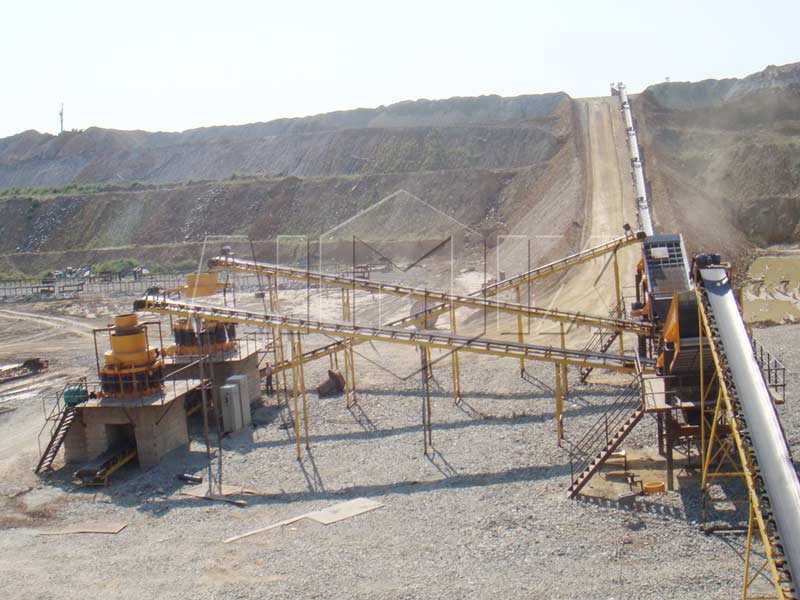Crusher Plants
Contents |
[edit] Types of crusher plant
Portable crusher plant consists of components like frame, assembly and hosts & accessories, a power system, a hydraulic electronic control system, and belt conveyors for moving the finished products. They are hooked up to a trailer and moved by wheels. The hydraulic cylinder controls the movements of equipment and materials are delivered to the hosts and belt conveyors for transportation of finished products.
There are many features of using a portable crushing plant, and this short article will explain the various kinds of crushers.
[edit] Mobile crushing plants
As the name suggests, mobile crushing plants move from one place to another. They can be highly engineered mobile systems that happen to be assembled over a moving frame. Because they move, they are simpler to maintain and repair. As they are mobile, they are often repositioned to provide various projects and will be resold as used equipment if required. The mobile crushing plant has some advantages over stationary plant.
[edit] Jaw crushers
A transportable crusher plant with jaw crushers is a versatile item of equipment that may serve as a primary, secondary, or tertiary crusher. It can be a good choice for crushing aggregates in a range of applications, from mining to recycling. Portable jaw plants comes along with a wide range of options, including customisable and fast-setup models. Portable jaw crushers are the most common selection for primary crushing, while portable cone crushers can process almost any rock type.
[edit] Cone crushers
Portable crushing units are designed for secondary or tertiary applications and give high capacity and versatility. They have a unique design with advanced features that combine mobility and adaptability, rich in production and uptime, inexpensive-per-tonne, and easy for maintenance.
[edit] Impact crushers
Impact crushers for portable crusher plants are good for recycling concrete and natural rock, and they are often self-contained and mobile. They can be operated with a single operator and move straight to materials they are crushing. In some models, they may even move on tracks while crushing. Impact crushers are highly productive and are suitable for recycling applications where high-grade aggregate is important.
[edit] Mobile screening plants
Together with their traditional roles as crushing plants, portable screening and crushing plants may also be highly versatile. A portable screening plant is competent at producing three sizes of finished product simultaneously. It is operated by employing a wireless remote device. Heavy-duty screening plants are a good option for the processing of soils, scrap, demolition debris, and construction debris.
[edit] Portable crusher plant
Self-contained portable crusher plant is easy to operate and transport. Feed box tipping points enable loading by having a small excavator or skid steer. Jaw settings are fully adjustable for optimum production and product quality. Operation is fully automated via a remote device, enabling easy troubleshooting and maintenance.
[edit] Related articles on Designing Buildings
Featured articles and news
Amendment to the GB Energy Bill welcomed by ECA
Move prevents nationally-owned energy company from investing in solar panels produced by modern slavery.
Gregor Harvie argues that AI is state-sanctioned theft of IP.
Heat pumps, vehicle chargers and heating appliances must be sold with smart functionality.
Experimental AI housing target help for councils
Experimental AI could help councils meet housing targets by digitising records.
New-style degrees set for reformed ARB accreditation
Following the ARB Tomorrow's Architects competency outcomes for Architects.
BSRIA Occupant Wellbeing survey BOW
Occupant satisfaction and wellbeing tool inc. physical environment, indoor facilities, functionality and accessibility.
Preserving, waterproofing and decorating buildings.
Many resources for visitors aswell as new features for members.
Using technology to empower communities
The Community data platform; capturing the DNA of a place and fostering participation, for better design.
Heat pump and wind turbine sound calculations for PDRs
MCS publish updated sound calculation standards for permitted development installations.
Homes England creates largest housing-led site in the North
Successful, 34 hectare land acquisition with the residential allocation now completed.
Scottish apprenticeship training proposals
General support although better accountability and transparency is sought.
The history of building regulations
A story of belated action in response to crisis.
Moisture, fire safety and emerging trends in living walls
How wet is your wall?
Current policy explained and newly published consultation by the UK and Welsh Governments.
British architecture 1919–39. Book review.
Conservation of listed prefabs in Moseley.
Energy industry calls for urgent reform.




























